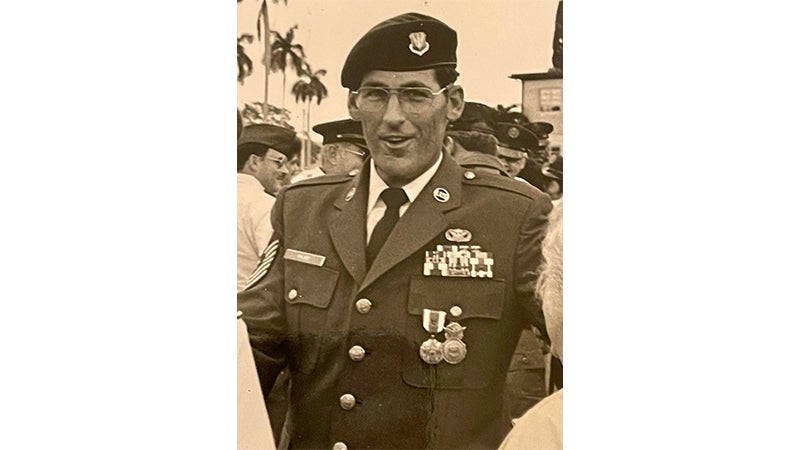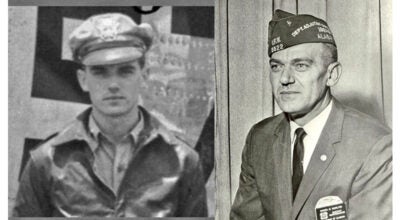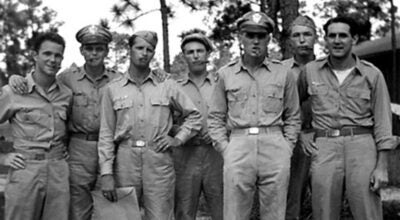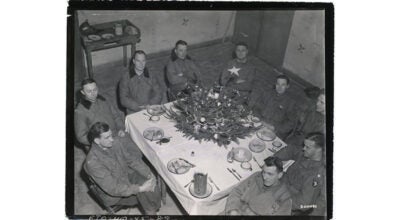Gerald Walker, Chief Master Sergeant, U. S. Air Force, Vietnam War
Published 1:00 pm Friday, May 5, 2023

- Chief Master Sergeant Gerald Walker, Vietnam Veteran. [Photo: Terese Jagels]
|
Getting your Trinity Audio player ready...
|
Gerald Walker was attached to the U. S. Air Force’s “Ranch Hands,” the 12th Special Operations Squadron, also known as the “defoliators.” They flew C-123s on defoliation missions to all areas of S. Vietnam from their base at Bien Hoa. After the war, a lone C-123 was flown to Wright Patterson Air Force Base to be placed in the air museum. They nicknamed the aircraft “Patches,” because there were more than 500 bullet holes in the plane.
Gerald Walker was born September 6, 1946, at Ramer, Alabama. His parents were Ruben and Lucy Faulk Walker. He was the fifth among five children. The family moved to Andalusia, Alabama, in 1955 and Gerald attended Andalusia schools, graduating from Andalusia High School in 1964. He worked at the Alatex shirt factory for about a year before joining the Air Force.
In August 1965, Gerald attended basic training at Lackland Air Force Base in San Antonio, Texas. He did further training at Chanute AFB in Illinois before being assigned to Barksdale AFB in Bossier City, Louisiana. At Barksdale, Gerald was trained as a “life support specialist.” His job was to inspect and maintain all survival gear.
Gerald Walker was deployed to Vietnam from Travis AFB California, in 1968. He was assigned to the “Ranch Hands,” the Air Force’s 12th SOS at Bien Hoa. At the time, Bien Hoa was the largest Air Force base in the world, which included the main helicopter base for U. S. forces in Vietnam.
During his eight months at Bien Hoa, Walker flew to other military bases in Vietnam, making sure all life support and survival gear was kept up-to-date. Occasionally, Walker’s Commanding Officer, Lt. Col. Rex Stone, would allow him to fly on spraying missions.
Walker recalled his living quarters at Bien Hoa, “The only air-conditioned building for enlisted personnel was the NCO [non-commissioned officers] Club. We lived in a heavily sand-bagged building called a ‘hooch.’ It slept 27 men and the top was covered by poles. You could see large rats crawling up there. After eating, you had to make sure you washed away any smell of food because the rats would bite you at night. If you were bitten and didn’t have the rat tested for rabies, you had to undergo a series of rabies vaccinations…We took malaria tablets daily or one large tablet that was effective for a week. The large tablet tended to cause diarrhea.”
Walker recalled his time at Bien Hoa, “In 1968, our base was often attacked by the Viet Cong [VC]. There was also a danger from snipers who hid in the nearby jungle…Casualties in the field were triaged at Long Binh, then evacuated to Bien Hoa for further transport to Yokota Air Base in Japan or Clark AFB in the Philippines…. Casualties needing further care were evacuated to hospitals in the States, such as Ft. Sam Houston, Texas, Bethesda Naval Hospital in Maryland and Walter Reid Army Hospital in Washington, D. C.”
In September 1968, Walker was sent to Jungle Survival School near Subic Bay Naval Base in the Philippines. After eight months at Bien Hoa, Walker had been promoted to Staff Sergeant. Upon completion of the school, Walker returned to Bien Hoa and taught jungle survival training and refresher training at various bases in Vietnam. Walker was sent to Da Nang after eight months at Bien Hoa. At Da Nang, he performed similar duties as those at Bien Hoa. After four months at Da Nang, Walker decided to make a career of the Air Force.He returned to the States in August 1969 and was assigned to McConnell AFB in Wichita, Kansas, which was home to the 381st Titan Missile Wing.
At McConnell, Walker helped maintain the hazmat suits worn by maintenance and refueling personnel. The fuel and oxidizer used by the Titan missile were highly toxic. Workers fueling and defueling the Titan, breathed a mixture of oxygen and nitrogen. The safety of their equipment was dependent upon airmen like Walker.
After a year at McConnell, Walker was sent to Barksdale AFB for a year before being assigned to Hickam AFB, Hawaii. He remembers Hawaii as one of the best places that he served. He made Tech Sergeant while at Hickam.
From Hawaii, Walker was sent to Homestead AFB, Florida, where he served for three years and was promoted to Master Sergeant. After three years at Homestead, he was sent to Davis-Monthan AFB in Tucson, Arizona, in 1980. He helped set up the life support program there for the first time. He was also part of the initial team that set up Electronic Warfare Operations aboard the EC-130. After three years, he was assigned to the Inspector General’s staff at Langley AFB, Virginia. Langley AFB was the Headquarters of the Tactical Air Command. Walker inspected life support facilities at various bases with the Inspector General’s team. While at Langley, Walker was promoted to Senior Master Sergeant [E-8].
In 1986, Walker was assigned to Torrejon AFB near Madrid, Spain. He became the Wing Life Support Superintendent and trained life support specialists for the Air Force Wing. Walker was also part of the Wing’s self-evaluation team when they flew to forward operating bases in Incirlik, Turkey and Aviano AFB in Italy. He was promoted to Chief Master Sergeant [E-9] while in Spain.
After two years in Spain, Walker was assigned to Homestead AFB where he cross-trained as a military policeman. He retired at Homestead in September 1990 at the age of 44, after 25 years of active duty. He had been awarded five Air Force Commendation Medals and four Meritorious Service Medals.
After retirement from the Air Force, Walker worked security for The Wackenhut Corporation on the Metrorail in south Florida. In 1995, He moved to Andalusia, Alabama, where he worked for Shorewood Packaging Corporation for five years. In 2001, he took a job at Ft. Rucker Army Air Base, working as a civilian life support contractor. In 2009, Gerald Walker retired.
Gerald met and married Helen Odom Dubose in 2002. Helen had two sons, Dennis [Tina] and Darrin [Jennifer] O’Neal, and Gerald had a daughter, Terese [Mike] Jagels. They have five grandchildren and six great-grandchildren. Gerald and Helen currently reside in Andalusia.
John Vick
The author thanks Gerald Walker for sharing his story.
[Sources: Wikipedia, af.mil, and history.com]
Author’s special note: In 1961, President John F. Kennedy authorized the spraying of herbicides onto the forests and croplands of South Vietnam [Operation Trail Dust]. The purpose was to remove vegetation and jungle canopy that gave cover for the Viet Cong and N. Vietnamese Armies and to prevent crops from being grown to feed the enemy. From 1961-1971, the U. S. forces sprayed some 19 million gallons of the chemicals, 2-4 D and 2-4-5 T [a mixture referred to as Agent Orange] at 50 times the normal agricultural concentrations. The original purpose might have been well intentioned, but the consequences were horrific for the South Vietnamese people and the American fighting men. They were exposed to deadly dioxins [known carcinogens] contained in Agent Orange that left a legacy of cancers and other physical and mental illnesses that are still prevalent today.
More COLUMN -- FEATURE SPOT





